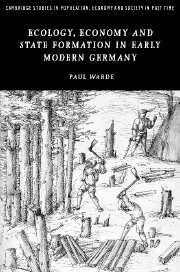Book contents
- Frontmatter
- Contents
- List of figures
- List of maps
- List of tables
- Acknowledgements
- Glossary
- List of abbreviations
- Introduction
- 1 The peasant dynamic
- 2 Power and property
- 3 The regulative drive
- 4 From clearance to crisis?
- 5 The two ecologies
- Conclusions
- Bibliography
- Index
- Cambridge Studies in Population, Economy and Society in Past Time
5 - The two ecologies
Published online by Cambridge University Press: 24 July 2009
- Frontmatter
- Contents
- List of figures
- List of maps
- List of tables
- Acknowledgements
- Glossary
- List of abbreviations
- Introduction
- 1 The peasant dynamic
- 2 Power and property
- 3 The regulative drive
- 4 From clearance to crisis?
- 5 The two ecologies
- Conclusions
- Bibliography
- Index
- Cambridge Studies in Population, Economy and Society in Past Time
Summary
In the ‘Wooden Age’ nearly everything involved wood at some point in its production. There was no iron without charcoal or wood for pit-props and pickaxe handles, no glass or soap without potash, no transport of anything above a minimal bulk without carts, sledges, wagons and rivercraft. The previous three chapters have identified the kinds of wood that people needed, the uses to which woodland was generally put, and the manner in which such flows were regulated. This chapter will develop these themes further, with two areas particularly in mind. One is the spatial distribution of the production and consumption of wood, the form of exchange involved, and the identification of what ecologists would call ‘sources’ (points of origin) and ‘sinks’ (points of consumption) of the resource. Tracing these patterns over time will allow us to address questions of the nature of economic development, and the causes of landscape and environmental change. Understanding these processes, however, requires more than the mapping of material flows. It is also essential to comprehend how people thought about such movements and exchanges in a world strongly shaped by both institutional imperatives, and a straightforward fear of suffering, illness and mortality. In the cold winter of 1743, for example, the ducal authorities attempted to enforce the mandatory limit of two ‘wood days’ for cutting and collection in the Vorstwald of Bietigheim. But the snow lay deep on the ground that December, and local authorities objected.
- Type
- Chapter
- Information
- Ecology, Economy and State Formation in Early Modern Germany , pp. 280 - 346Publisher: Cambridge University PressPrint publication year: 2006

